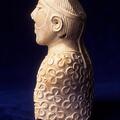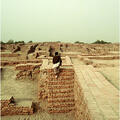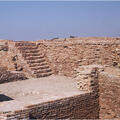Slides on the archaeology and excavation of ancient Indus Valley sites including Harappa by Jonathan Mark Kenoyer of the University of Wisconsin, Madison.
Eroded face of Granary
The eroding wells and a wall built up against the granary show that much of the area to the north of the granary was filled with debris and later buildings.
View of well to the east of the Granary
Looking from the top of the granary towards the remains of two wells and the wall that were constructed in the area to the north of the structure. The drain from the great bath would have run along the modern pathway.
Western Staircase, House I, HR area
Many houses had stairs leading to upper courtyards of the building or to a second floor. This house in HR area had a double staircase that would allow people to enter and exit the upper courtyard in an orderly fashion.
Sculpture
Seated male sculpture with shell inlay still remaining in one eye. The braided or combed hair lays back straight and a plain fillet or ribbon encircles the head and falls down the back of the neck.
House I, HR area
House A1 may have been a temple or palace of an important leader. Two doorways lead to a narrow courtyard at a lower level. A double staircase leads to an upper courtyard surrounded by several rooms.
Seated male
Seated male figure with head missing (45,46). On the back of the figure, the hair style can be partially reconstructed by a wide swath of hair and a braided lock of hair or ribbon hanging along the right side of the back.
A cloak is draped over the
Well surrounded by paving, DK-B area
This well located in DK-B area was originally surrounded by a paving that has recently been reconstructed.










